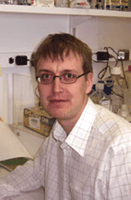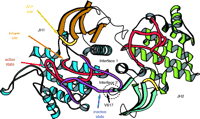Identification of an Acquired Mutation in Jak2 Provides Molecular Insights into the Pathogenesis of Myeloproliferative Disorders
- 1Molecular Immunology and Inflammation Branch, National Institute of Arthritis and Musculoskeletal and Skin Diseases,
- 2National Institute of Diabetes, Digestive and Kidney Disease, Laboratory of Genetics and Physiology, National Institutes of Health, Bethesda, MD 20892 USA;
- 3Institute of Medical Technology, University of Tampere and Department of Clinical Microbiology, Tampere University Hospital, FIN-33014 Tampere, Finland
The history of the chronic myeloproliferative disorders (CMDs) dates back over a hundred years, when Vaquez and later Osler described patients with cyanotic polycythemia, enlarged spleen, and liver. Today, Osler-Vaquez syndrome is usually referred to as polycythemia vera (PV); however, Dameshek recognized in the 1950s that PV belongs to a family of disorders including Essential Thrombocythemia (ET) and Chronic Idiopathic Myelofibrosis (CIMF) (1). The World Heath Organization currently includes Chronic Eosinophilic Leukemia (CEL), and Chronic Neutrophilic Leukemia (CNL) and Systemic Mast Cell Disease (SMCD) to the aforementioned disease family.
Dameshek had been remarkably prescient in recognizing that a shared pathogenic mechanism underlies PV, ET, and CIMF. Indeed, a remarkable series of recent papers has now established that a single, acquired mutation (V617F) in the pseudokinase domain of Janus kinase 2 (Jak2) is present in the majority of patients with PV, ET, and CIMF. These diseases serve as excellent examples of the power of molecular medicine in that we can readily link a vast body of literature on cytokine signaling with disease pathogenesis. With any luck, these insights will also lead to novel therapies. We briefly discuss the biology of erythropoietin (EPO), the role of Janus kinases in signaling by EPO and other cytokines, and the identification of Jak2 mutations. We will then relate how Jak2 activation is thought to contribute to the pathogenesis of CMD and what the implications are with respect to novel therapies.
Chronic myeloproliferative disorders are characterized by hypercellularity (i.e., excessive cell number) of the bone marrow, and overproduction of one or more of the different cell types. Several lines of evidence support the notion that the abnormal cell expansion is clonal, arising from a single pathologic stem cell. The altered cells are characterized by growth factor–independent or –hypersensitive proliferation. In some cases, this can result in the outgrowth of malignant cells in both blood and bone marrow [reviewed recently in (2)]. One abnormality characteristic of PV is endogenous erythroid colony (EEC) formation. This assay detects growth of erythroid progenitor cells in the absence of the key cytokine erythropoietin (EPO)––a cytokine long recognized to be a key regulator of erythropoiesis. Initially, the underlying abnormality in PV was thought to be a mutation of the EPO receptor (EPOR), but this turned out not to be the case. In fact, PV cells are not only hyperresponsive to EPO, but also have enhanced sensitivity to other cytokines that control hematopoiesis, such as interleukin (IL)-3, granulocyte-macrophage colony-stimulating factor (GM-CSF), and thrombopoietin. It is, therefore, relevant to discuss how cytokines such as these exert their effects.
Many cytokines that regulate hematopoiesis are structurally related, possessing a four α-helical domain architecture. These cytokines bind receptors that belong to the type I and type II cytokine receptor families (3, 4). When these receptors were first cloned, it was not immediately evident how these receptors signaled; however, with the discovery of Jaks in the early 1990s, it soon became clear that this family of kinases that could bind to cytokine receptors is required for the initiation of signaling. Jaks are a small family of structurally unique, cytoplasmic tyrosine kinases, consisting of four members: Jak1, Jak2, Jak3, and Tyk2. A large number of studies documented the involvement in signaling by various cytokines and interferons. Indeed, the following paradigm is recognized as an elegantly simple mechanism for signal transduction: Upon a cytokine binding to its receptor, receptor-bound Jaks become auto- or trans-phosphorylated on conserved residues in the kinase-domain activation loop. Activated Jaks then phosphorylate intracellular receptor chains that provide docking sites that serve to recruit Src homology (SH) 2 domain-containing substrates. Jaks phosphorylate these receptor chain–associated substrates, including adaptor and docking molecules (e.g., Shc and Gab/IRS), and perhaps most importantly, the Signal Transducers and Activators of Transcription (Stat) transcription factors (5, 6). Activated Stats dimerize and translocate into the nucleus, where they bind to the promoter sequences of the target genes and regulate transcription. With respect to erythropoiesis, Stat5A and Stat5B are especially critical (7, 8).
The essential function of the Jaks in cytokine and interferon signaling was documented first using various Jak-deficient cell lines (9). Later, the generation of knockout mice and the identification of humans deficient in Jak3 established the crucial and non-redundant role of Jak kinases in vivo (5, 10). Of note, these studies clearly documented an essential role of Jak2 in Epo signaling. Jak2−/ − mice die at embryonic day 12.5, owing to a lack of definitive erythropoiesis (11, 12).
Based on their primary structure, seven Jak homology (JH) domains were recognized (6, 13). The C-terminal JH1 domain corresponds to the kinase or catalytic domain. The crystal structure of the Jak3 kinase domain has been solved recently and the overall architecture possesses the canonical bilobed structure observed in all other protein kinases (14). A hallmark of Janus kinases, however, is the presence of a second kinase domain. This catalytically inactive pseudokinase or kinase-like domain (also denoted the JH2 domain) is located adjacent to the functional C-terminal kinase domain (6). The JH1-JH2 structure is the basis of the name “Janus kinases”; like the Roman god Janus, they have two faces––in this case, kinase domains (Figure 1⇓). Although the pseudokinase domain in Jaks lacks catalytic activity, it does possess an important regulatory function (15, 16). That is, whereas the JH1 kinase domain alone of Jak2 or Jak3 is catalytically active, co-expression of the Jak2-JH2 domain inhibits the catalytic activity of Jak2, suggesting that the JH2 domain participates in a negative regulatory role (15, 16). Structure-function experiments in vitro have mapped the inhibitory function of JH2 primarily to amino acids 619–670, but other critical residues are also reported (i.e., 665 and 570) (17– 19). Of note, transforming mutations in Drosophila Jak, termed Hopscotch, have been identified, and one of these resides in the pseudokinase domain (18, 20). Although the complete structure of a Jak has not been elucidated, molecular modeling has been used to suggest how an inhibitory region in JH2 might interact with the kinase domain (21, 22). Parenthetically, it should be noted that studies of Jak3 have also pointed to a positive regulatory role of the pseudokinase domain (16). The remainder of the Jak molecule encompasses two additional domains: an SH2 domain, and a FERM [Four-point-one (4.1), Ezrin, Radixin, Moesin] domain. There is no evidence that the SH2 domain functions to bind tyrosine phosphorylated substrates; however, there are data indicating that this segment is important in regulating receptor association and trafficking of the Jak–cytokine receptor complex (23, 24). The FERM domain has been implicated in the cell-surface expression of several cytokine receptors, and it also regulates catalytic activity (16, 23, 25, 26). Thus, it is clear that even though our knowledge of Jak structure is incomplete, we know a great deal about the function of these kinases and their role in hematopoietic cell development and survival. So how does this relate to this pathogenesis of PV and other myeloproliferative diseases, and what led to the implication of Jak2 in these processes?
Chromosomal rearrangements in diseased cells have given clues to the molecular pathogenesis of these diseases––for example, the BCR-ABL trans-location in chronic myelogenous leukemia (also known as chronic myeloid leukemia) (CML). Similarly, in rare cases of human leukemia, translocations of the gene encoding the TEL transcription factor with the kinase domain of Jak2 result in the Tel-Jak2 fusion protein, which is also capable of transforming cells (27). Although the molecular mechanisms underlying PV, ET, and CIMF were elusive, cytogenetic studies demonstrated deletions in chromosome 20 and loss-of-heterozygosity (LOH) in chromosome 9p (28, 29). Notably, the polycythemia LOH site in chromosome 9p contains the gene that encodes Jak2.
To clarify the pathogenesis of PV, ET, and CIMF, five different groups focused their research on Jak2 using different strategies. The Swiss-Italian group concentrated their research on Jak2 based on the LOH at the site of the Jak2 gene. The Cambridge and Nashville groups suspected Jak2 as a candidate given its role in hematopoiesis. French investigators tested the effect of Jak2 siRNA on EEC formation, whereas the Boston group used a high-throughput DNA sequencing approach focusing on the activation loops and inhibitory domains of eighty-five tyrosine kinases. The same conclusion was reached by all groups: the vast majority of the PV patients (up to 97%) and a significant portion of the patients with other myeloproliferative disorders carry a single point mutation, V617F, in the JH2 domain of Jak2 (30–34). Somatic missense mutations occurred in the Jak2 gene in 74–97% of patients with PV, 33–57% of patients with ET and 35–50% of those with CIMF, but strikingly, mutation was completely absent in normal control samples or patients with secondary erythrocytosis. In addition, PV patients lacked any other mutations in the activation loops or autoinhibitory domains of eighty-five other kinases. Most patients carry only one copy of the V617F mutated gene, but approximately one-third were reported as homozygous in these studies, presumably because of a mitotic crossover and clonal expansion. In the majority of cases, the V617F mutation is acquired (as opposed to being present as a germ-line mutation), owing to its detection in blood cells that exhibit rapid turnover. In a small portion of patients, however, V617F was identified in DNA from buccal swabs, implying that the mutation occasionally occurs as a germ-line mutation.
After the initial identification of the V617F mutation, confirmatory investigations were performed, which strongly support the notion that the mutation directly contributes to the pathogenesis of myeloproliferative diseases. The mutation was observed to provide growth advantage to affected cells as illustrated by patients with mixed clonal and polyclonal progenitors; only erythroid progenitors carrying the mutation were able to grow in the absence of exogenous EPO. Conversely, reduction of Jak2 expression by small interfering (si)RNA reduced EEC formation by 90%. In cell lines, expression of the mutant kinase resulted in Jak2 autoactivation and increased phosphorylation of Stat5 in the absence of Jak2-activating growth factors. Moreover, the occurrence of cross-over events, which lead to loss of heterozygosity, further suggests that mutation provides a proliferative advantage, allowing the replacement of the clone of cells carrying a single mutant Jak2 locus. The proliferation-promoting ability of Jak2 V617F is clearly demonstrated in experiments where cells expressing only the mutant Jak2 were compared with co-expression of both wild type and mutant Jak2. Wild-type Jak2 expression reduced the total cellular autonomous Jak2 activity, resulting in diminished growth factor independency. Further evidence comes from the experiments in which V617F Jak2 has been transduced into murine bone marrow cells; transplantation of mutant, but not the wild-type kinase, transduced cells into sublethally irradiated mice recipients leads to substantial and significant erythrocytosis as measured by hematocrit (Hct, the percentage volume of whole blood taken up by erythrocytes): Hct ~ 60%, whereas normal Hct ~ 40%.
These findings are exciting because they have a number of important basic and clinical implications. Clearly, the identification of V617F mutations opens up a new era in diagnosis of chronic myeloproliferative diseases. The findings raises the question as to how the mutation contributes to different types of myeloproliferative disorders; nearly all PV patients but less than half of the ET cases have this mutation. Why is this so? It is also of interest to consider what mechanisms select for this single mutation: How and why does this occur? Might this mutation arise in other tissues and affect the function other Jak2-dependent cytokines, such as growth hormone or leptin? The V671F mutation appears to be a germline alteration in a minority of patients; is this consequential in nonhematopoietic cells? Conversely, it also must be borne in mind that some of the patients lack the mutation completely, arguing that other mechanisms must exist. Regarding the role of Jak2 in myeloproliferative diseases, it is notable that downstream targets including Stats and the serine–threonine cytoplasmic kinase Akt are hyperactivated (35, 36). How important are these intermediates with respect to disease pathogenesis? It may be most effective to create mouse models to dissect the pathways that lead to myeloproliferative disease. Expression of the mutant Jak2 in erythroid cells that lack Stat5, EPOR, or Bcl-XL, followed by their transplantation into lethally irradiated mice, should provide a mechanistic understanding on the pathways taken by the V617F mutant protein. The use of mice harboring conditional gene knock-outs should permit mechanistic studies on the role of these proteins in the initiation process versus maintenance of PV. It will also be important to precisely define how the V617F mutation changes Jak2 function at the molecular level. The mutation results in the lack of autoinhibition possibly by destabilizing the JH1-JH2 interaction. Alternatively, the mutation could also affect Jak2 interaction with other regulatory proteins, such as suppressors of cytokine signaling (SOCS) proteins or phosphatases. In either case, the finding raises the possibility of targeting Jak2 to treat these disorders. Clearly, the feasibility of generating selective Jak inhibitors has now been established with the identification of a potent, specific, and orally available Jak3 inhibitor (37, 38). On one hand, one might imagine that inhibiting Jak2 would cause unacceptable anemia and/or thrombocytopenia; however, if it were possible to specifically inhibit the mutant version of Jak2, this would, in principle, provide selectivity.
In summary, the discovery that Jak2 mutations underlie PV and other myeloproliferative diseases is an exciting development for basic scientists and clinicians. The discoveries hold promise with respect to improved diagnosis and treatment. In addition, the findings provide impetus to better understand the regulation of the kinase activity of Jaks and to define the molecular mechanisms that control normal and abnormal hematopoiesis.
A schematic structure of Jak2-JH1-2 domains and predicted effect of the V617F mutation. The putative spatial orientation of JH1 and JH2 domains on the structure of growth factor receptor is shown. The JH1-JH2 interaction site, including the site of V617, is circled. The activation loop of JH1 has two possible conformations (active-red, inactive-purple); the ATP binding site is shown in yellow. It is thought that the JH2 can negatively regulate the JH1 or kinase domain. It is proposed that the V617F mutation destabilizes the JH1-JH2 interaction and thereby promotes activation of kinase activity. From Kaushansky, K. On the molecular origins of the chronic myeloproliferative disorders: It all makes sense. Blood 105, 4187–4190 (2005). Copyright American Society of Hematology, used with permission (39).
- © American Society for Pharmacology and Experimental Theraputics 2005
References

Olli Silvennoinen, MD, PhD, is a Professor and the Director of The Institute of Medical Technology, University of Tampere, Finland. Dr. Silvennoinen has been investigating the JAK–STAT pathway since the cloning and characterization of these genes, and one of his central interest areas has been the role of the JH2 domain in regulation of JAKs. E-mail: olli. silvennoinen{at}uta.fi; fax: +358-3-215 7332.

Lothar Hennighausen, PhD, uses the tools of molecular biology and mouse genetics to unlock secrets of normal development and disease. He has repeatedly performed groundbreaking research whether it be the more prosaic investigations of milk-protein gene regulation or the wide-reaching explorations of STAT5 signaling. He has made seminal observations about development of the normal mammary gland, which is reflected in the numerous citations of his research and inclusions of his work in basic texts. Lothar Hennighausen takes the same enthusiastic approach to activities outside the lab as he does inside. He is an avid alpine cyclist and competes in road races. E-mail: lotharh{at}amb.niddk.nih.gov.

John J. O’Shea received his MD from the University of Cincinnati and is Chief of the Molecular Immunology and Inflammation Branch at the National Institute of Arthritis and Musculoskeletal and Skin Diseases (NIAMS), Bethesda, Maryland, USA. He and his colleagues cloned human JAK3 and discovered that mutations result in severe combined immunodeficiency. He has co-authored more than 150 articles and is a recipient of both the National Institutes of Health Director’s Award and the US Public Health Researcher of the Year Award. He is board-certified in internal medicine and allergy–immunology and is a member of a number of scientific societies, including the American Association of Immunologists, the American College of Rheumatology and the American Society for Clinical Investigation. He is an associate editor of the Journal of Biological Chemistry. Email: osheaj{at}arb.niams.nih.gov; fax: 301-402-0012.

Marko Pesu, MD, PhD, is currently a visiting research fellow in the Lymphocyte Cell Biology Section at the National Institute of Arthritis and Musculoskeletal and Skin Diseases of the National Institutes of Health. His research focuses on evaluating cytokinesignaling pathways in lymphocytes. E-mail: pesum{at}mail.nih.gov




